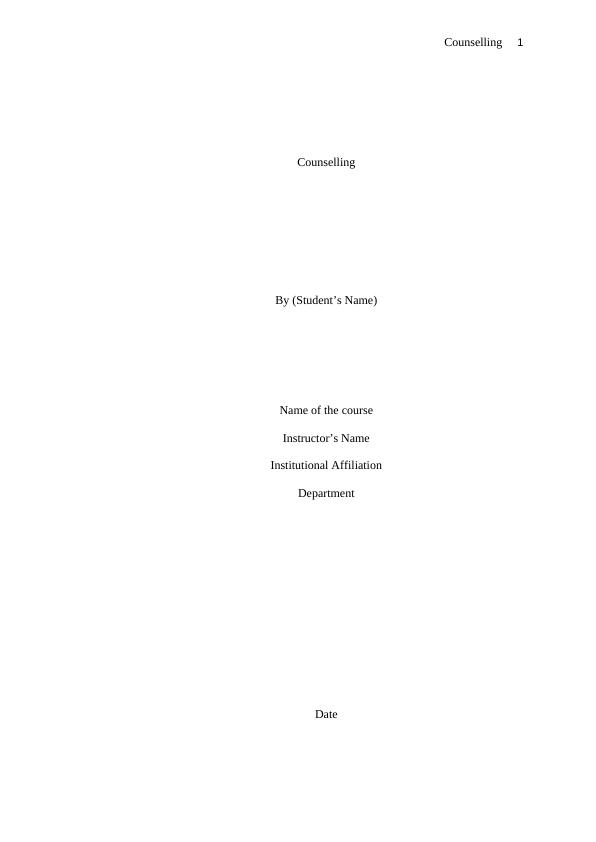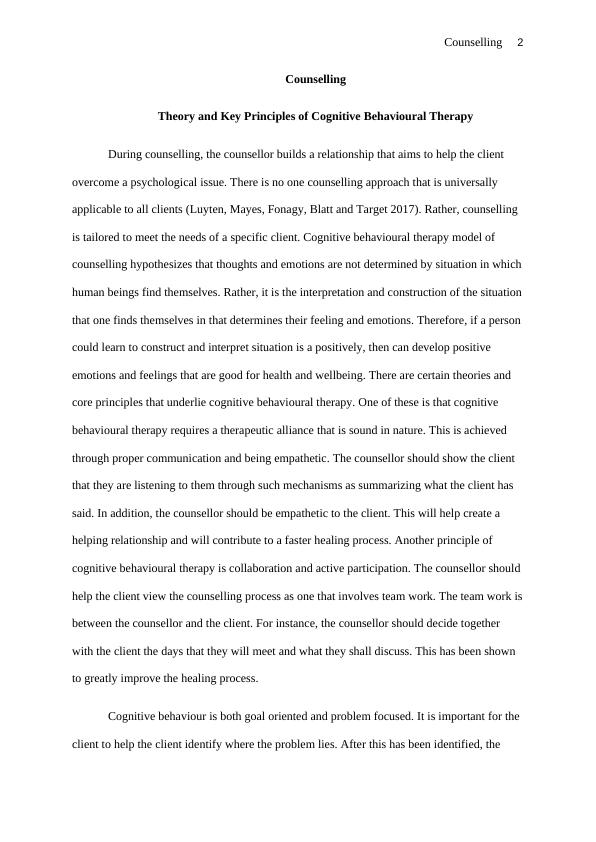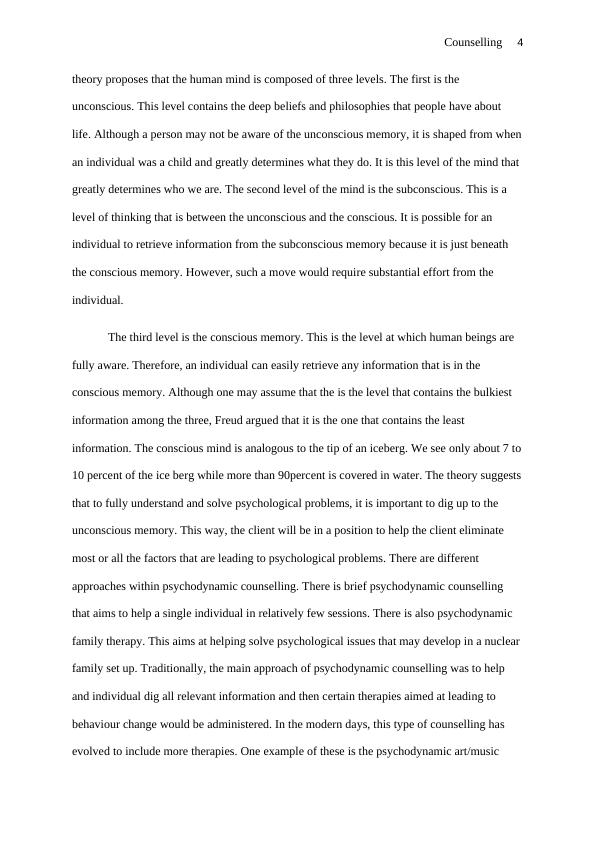Theory and Key Principles of Counselling
Added on 2023-04-20
14 Pages4005 Words122 Views
Counselling 1
Counselling
By (Student’s Name)
Name of the course
Instructor’s Name
Institutional Affiliation
Department
Date
Counselling
By (Student’s Name)
Name of the course
Instructor’s Name
Institutional Affiliation
Department
Date

Counselling 2
Counselling
Theory and Key Principles of Cognitive Behavioural Therapy
During counselling, the counsellor builds a relationship that aims to help the client
overcome a psychological issue. There is no one counselling approach that is universally
applicable to all clients (Luyten, Mayes, Fonagy, Blatt and Target 2017). Rather, counselling
is tailored to meet the needs of a specific client. Cognitive behavioural therapy model of
counselling hypothesizes that thoughts and emotions are not determined by situation in which
human beings find themselves. Rather, it is the interpretation and construction of the situation
that one finds themselves in that determines their feeling and emotions. Therefore, if a person
could learn to construct and interpret situation is a positively, then can develop positive
emotions and feelings that are good for health and wellbeing. There are certain theories and
core principles that underlie cognitive behavioural therapy. One of these is that cognitive
behavioural therapy requires a therapeutic alliance that is sound in nature. This is achieved
through proper communication and being empathetic. The counsellor should show the client
that they are listening to them through such mechanisms as summarizing what the client has
said. In addition, the counsellor should be empathetic to the client. This will help create a
helping relationship and will contribute to a faster healing process. Another principle of
cognitive behavioural therapy is collaboration and active participation. The counsellor should
help the client view the counselling process as one that involves team work. The team work is
between the counsellor and the client. For instance, the counsellor should decide together
with the client the days that they will meet and what they shall discuss. This has been shown
to greatly improve the healing process.
Cognitive behaviour is both goal oriented and problem focused. It is important for the
client to help the client identify where the problem lies. After this has been identified, the
Counselling
Theory and Key Principles of Cognitive Behavioural Therapy
During counselling, the counsellor builds a relationship that aims to help the client
overcome a psychological issue. There is no one counselling approach that is universally
applicable to all clients (Luyten, Mayes, Fonagy, Blatt and Target 2017). Rather, counselling
is tailored to meet the needs of a specific client. Cognitive behavioural therapy model of
counselling hypothesizes that thoughts and emotions are not determined by situation in which
human beings find themselves. Rather, it is the interpretation and construction of the situation
that one finds themselves in that determines their feeling and emotions. Therefore, if a person
could learn to construct and interpret situation is a positively, then can develop positive
emotions and feelings that are good for health and wellbeing. There are certain theories and
core principles that underlie cognitive behavioural therapy. One of these is that cognitive
behavioural therapy requires a therapeutic alliance that is sound in nature. This is achieved
through proper communication and being empathetic. The counsellor should show the client
that they are listening to them through such mechanisms as summarizing what the client has
said. In addition, the counsellor should be empathetic to the client. This will help create a
helping relationship and will contribute to a faster healing process. Another principle of
cognitive behavioural therapy is collaboration and active participation. The counsellor should
help the client view the counselling process as one that involves team work. The team work is
between the counsellor and the client. For instance, the counsellor should decide together
with the client the days that they will meet and what they shall discuss. This has been shown
to greatly improve the healing process.
Cognitive behaviour is both goal oriented and problem focused. It is important for the
client to help the client identify where the problem lies. After this has been identified, the

Counselling 3
clients can then be guided through the process of making specific goals that are aimed
towards improving the situation. Another principle and theoretical concept behind cognitive
behavioural therapy is that counselling therapy should focus on the problems/ challenges that
the client is experiencing at the present. This has been shown to facilitate the process of faster
recovery. There are two instances however, where therapy should focus on what the client
experienced in the past. One is where the client expresses a strong desire to do so. The second
instance is when failure to do so would significantly affect the therapeutic care in a negative
manner. Historically, cognitive behavioural therapy has been used to help clients identify
their thought processes and the counsellor would recommend the best strategies to help the
client recover. In the modern days however, there has been a shift towards team work
between the counsellor and the client. The client is treated as the most important party and
everything is done to ensure that they are helped to overcome their conditions. In the modern
days, there has been numerous research that has helped to greatly improve the quality of
cognitive therapeutic care. The future of cognitive therapeutic counselling seems even more
promising due to ongoing research.
Theories and Key Principles of Psychodynamic Counselling.
Psychodynamic therapy is also referred to as global therapy. This is because it focuses
on offering holistic care to the client. This is unlike most other approaches to counselling
because they are problem based. For instance, cognitive behavioural therapy aims at
correcting specific negative behaviours. Psychodynamic counselling focuses on
understanding what the client has underwent since they were a child until the present. With
this kind of history, it is possible to offer care that eliminates all possible underlying
psychological conditions so that the client can lead a more fulfilling life. There are several
theoretical and key principles behind psychodynamic theory. The main theory behind
psychodynamic counselling was developed by Sigmund Freud in the late 19th century. The
clients can then be guided through the process of making specific goals that are aimed
towards improving the situation. Another principle and theoretical concept behind cognitive
behavioural therapy is that counselling therapy should focus on the problems/ challenges that
the client is experiencing at the present. This has been shown to facilitate the process of faster
recovery. There are two instances however, where therapy should focus on what the client
experienced in the past. One is where the client expresses a strong desire to do so. The second
instance is when failure to do so would significantly affect the therapeutic care in a negative
manner. Historically, cognitive behavioural therapy has been used to help clients identify
their thought processes and the counsellor would recommend the best strategies to help the
client recover. In the modern days however, there has been a shift towards team work
between the counsellor and the client. The client is treated as the most important party and
everything is done to ensure that they are helped to overcome their conditions. In the modern
days, there has been numerous research that has helped to greatly improve the quality of
cognitive therapeutic care. The future of cognitive therapeutic counselling seems even more
promising due to ongoing research.
Theories and Key Principles of Psychodynamic Counselling.
Psychodynamic therapy is also referred to as global therapy. This is because it focuses
on offering holistic care to the client. This is unlike most other approaches to counselling
because they are problem based. For instance, cognitive behavioural therapy aims at
correcting specific negative behaviours. Psychodynamic counselling focuses on
understanding what the client has underwent since they were a child until the present. With
this kind of history, it is possible to offer care that eliminates all possible underlying
psychological conditions so that the client can lead a more fulfilling life. There are several
theoretical and key principles behind psychodynamic theory. The main theory behind
psychodynamic counselling was developed by Sigmund Freud in the late 19th century. The

Counselling 4
theory proposes that the human mind is composed of three levels. The first is the
unconscious. This level contains the deep beliefs and philosophies that people have about
life. Although a person may not be aware of the unconscious memory, it is shaped from when
an individual was a child and greatly determines what they do. It is this level of the mind that
greatly determines who we are. The second level of the mind is the subconscious. This is a
level of thinking that is between the unconscious and the conscious. It is possible for an
individual to retrieve information from the subconscious memory because it is just beneath
the conscious memory. However, such a move would require substantial effort from the
individual.
The third level is the conscious memory. This is the level at which human beings are
fully aware. Therefore, an individual can easily retrieve any information that is in the
conscious memory. Although one may assume that the is the level that contains the bulkiest
information among the three, Freud argued that it is the one that contains the least
information. The conscious mind is analogous to the tip of an iceberg. We see only about 7 to
10 percent of the ice berg while more than 90percent is covered in water. The theory suggests
that to fully understand and solve psychological problems, it is important to dig up to the
unconscious memory. This way, the client will be in a position to help the client eliminate
most or all the factors that are leading to psychological problems. There are different
approaches within psychodynamic counselling. There is brief psychodynamic counselling
that aims to help a single individual in relatively few sessions. There is also psychodynamic
family therapy. This aims at helping solve psychological issues that may develop in a nuclear
family set up. Traditionally, the main approach of psychodynamic counselling was to help
and individual dig all relevant information and then certain therapies aimed at leading to
behaviour change would be administered. In the modern days, this type of counselling has
evolved to include more therapies. One example of these is the psychodynamic art/music
theory proposes that the human mind is composed of three levels. The first is the
unconscious. This level contains the deep beliefs and philosophies that people have about
life. Although a person may not be aware of the unconscious memory, it is shaped from when
an individual was a child and greatly determines what they do. It is this level of the mind that
greatly determines who we are. The second level of the mind is the subconscious. This is a
level of thinking that is between the unconscious and the conscious. It is possible for an
individual to retrieve information from the subconscious memory because it is just beneath
the conscious memory. However, such a move would require substantial effort from the
individual.
The third level is the conscious memory. This is the level at which human beings are
fully aware. Therefore, an individual can easily retrieve any information that is in the
conscious memory. Although one may assume that the is the level that contains the bulkiest
information among the three, Freud argued that it is the one that contains the least
information. The conscious mind is analogous to the tip of an iceberg. We see only about 7 to
10 percent of the ice berg while more than 90percent is covered in water. The theory suggests
that to fully understand and solve psychological problems, it is important to dig up to the
unconscious memory. This way, the client will be in a position to help the client eliminate
most or all the factors that are leading to psychological problems. There are different
approaches within psychodynamic counselling. There is brief psychodynamic counselling
that aims to help a single individual in relatively few sessions. There is also psychodynamic
family therapy. This aims at helping solve psychological issues that may develop in a nuclear
family set up. Traditionally, the main approach of psychodynamic counselling was to help
and individual dig all relevant information and then certain therapies aimed at leading to
behaviour change would be administered. In the modern days, this type of counselling has
evolved to include more therapies. One example of these is the psychodynamic art/music

End of preview
Want to access all the pages? Upload your documents or become a member.
Related Documents
Important Qualities of a Therapist: Congruence, Unconditional Positive Regard, Empathetic Understanding, Multicultural Awareness, and Self-Reflectionlg...
|12
|2485
|249
Person Centred Approach and Cognitive Behavioural Therapylg...
|7
|1752
|1
Theories of Counsellinglg...
|8
|2692
|370
Theories of Counseling: Person-Centered Care and Cognitive Behavioral Therapylg...
|12
|3228
|184
Psychology Assignment: Counsellinglg...
|10
|3341
|68
Cognitive Behavioral Therapy | Essaylg...
|8
|2260
|23
